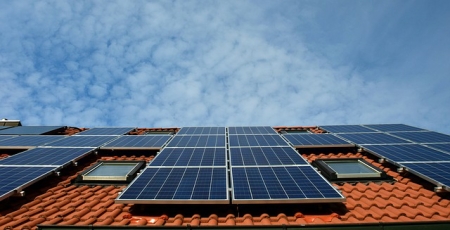Carbon ratings for buildings
Contents |
[edit] Introduction
Net zero energy, zero carbon, carbon neutral, carbon positive: some increasingly popular terms in building design. But do we really know what each of them means and how they contribute to our roadmap to a post-carbon UK economy?
Net zero energy refers to buildings where the total amount of annual energy consumed is equal to the renewable energy generated on the site. However, on a day-to-day basis the grid may be used to export excess renewable energy generation, with energy pulled from the grid in times of deficit.
Carbon neutral (or net zero carbon) refers to a building where all carbon emissions associated with operational energy demands of the building are offset by renewable energy provision, either on- or off-site.
Zero carbon is used to refer to a building where its operation does not lead to any carbon emissions. This would essentially be a building that could operate off-grid, generating sufficient energy from building-integrated renewable sources and combining this with battery and thermal storage to enable operation at times of no renewable energy production.
The term ‘Zero Carbon’ has also, arguably, been incorrectly used in the London Plan. There, zero carbon, actually refers to achieving carbon neutrality of regulated emissions only (space heating, hot water, cooling, lighting and auxiliary energy). In addition, offset payments are allowed as part of the strategy to deliver ‘zero carbon’.
Carbon positive buildings go beyond zero carbon and produce more energy than they need, with carbon emissions from the building’s operational energy consumption being less than the carbon emissions off-set by renewable energy generation. A carbon positive development could also effectively assist with energy demand management, interacting with the grid, electric vehicles and batteries to reduce peak energy demand, and, thereby, grid demand.
[edit] Where does UK construction currently stand?
Previously, the government’s ‘Zero carbon homes’ policy introduced in 2006 required all homes to be net zero carbon from 2016 and included all operational building emissions (both regulated and unregulated). Following the exclusion of unregulated energy from the ‘Zero carbon’ definition in 2011, the policy was finally scrapped in 2015, to the great disappointment of environmentalists, sustainability leaders and global thinkers.
The London Plan is currently leading the drive for low carbon construction in the UK and requires new major developments in London to be net zero carbon (aka carbon neutral). However, this is translated into a minimum on-site carbon reduction of 35% over Building Regulations, allowing the residual 65% of emissions to be off-set via a financial contribution to the borough.
Nevertheless, carbon neutrality is deemed the ‘easy way out’, the not-so-desirable substitute for zero carbon. The building still releases carbon emissions into the atmosphere, even if carbon savings delivered elsewhere through off-set payments could be robustly demonstrated.
It should also be noted that none of the above definitions currently deal with embodied carbon, the carbon associated to extraction, manufacturing and transport of building materials, the construction process, and the emissions from deconstructing and disposing at the end of the building’s lifetime. So, even if the UK construction industry were delivering net zero carbon buildings, we would still have a carbon problem.
[edit] Where do we need to be?
Zero carbon is currently regarded as the best practice and must be the aspirational target for new buildings if we are to keep global temperature increases to below 2 degrees.
When zero carbon becomes the norm, carbon positive dwellings will play a crucial role in tackling climate change and global warming, with buildings potentially being capable of making up for the carbon stemming from personal activities such as transport, food, goods purchasing etc.
Inevitably there are many more labels for low carbon and sustainable developments; whole life carbon positive, climate neutral, climate positive, positive development are all terms that require us to take a step back, see the bigger picture and understand the potential of buildings to contribute to ecological restoration, social justice and financial growth.
--KLH Sustainability 13:46, 22 Feb 2019 (BST)
[edit] Related articles on Designing Buildings Wiki
- A zero-carbon UK by 2050?
- Allowable solutions.
- BREEAM.
- Buildingomics.
- Carbon capture and storage.
- Carbon emissions.
- Carbon negative.
- Carbon Plan.
- Climate change Act.
- Code for Sustainable Homes.
- Domestic micro-generation.
- Eco town.
- Emission rates.
- Energy Act.
- Energy performance certificate.
- Fabric first.
- Green building.
- Low or zero carbon technologies.
- Nearly zero-energy building.
- Net zero carbon buildings.
- Renewable energy.
- Sustainability.
- Zero Bills Home.
- Zero carbon home.
- Zero carbon non-domestic buildings.
- Zero carbon task group.
Featured articles and news
Homes England creates largest housing-led site in the North
Successful, 34 hectare land acquisition with the residential allocation now completed.
Scottish apprenticeship training proposals
General support although better accountability and transparency is sought.
The history of building regulations
A story of belated action in response to crisis.
Moisture, fire safety and emerging trends in living walls
How wet is your wall?
Current policy explained and newly published consultation by the UK and Welsh Governments.
British architecture 1919–39. Book review.
Conservation of listed prefabs in Moseley.
Energy industry calls for urgent reform.
Heritage staff wellbeing at work survey.
A five minute introduction.
50th Golden anniversary ECA Edmundson apprentice award
Showcasing the very best electrotechnical and engineering services for half a century.
Welsh government consults on HRBs and reg changes
Seeking feedback on a new regulatory regime and a broad range of issues.
CIOB Client Guide (2nd edition) March 2025
Free download covering statutory dutyholder roles under the Building Safety Act and much more.
Minister quizzed, as responsibility transfers to MHCLG and BSR publishes new building control guidance.
UK environmental regulations reform 2025
Amid wider new approaches to ensure regulators and regulation support growth.
BSRIA Statutory Compliance Inspection Checklist
BG80/2025 now significantly updated to include requirements related to important changes in legislation.
























